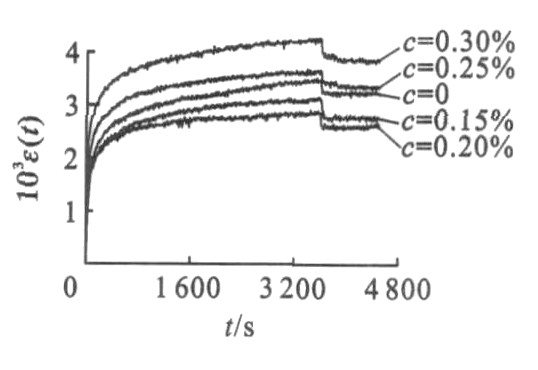Viscoelastic performance analysis of fiber reinforced asphalt concrete
-
摘要: 为了研究纤维沥青混凝土的粘弹性能, 制作5种20个聚酯纤维沥青混凝土圆柱试件, 在MTS810材料试验机上进行单轴静压蠕变试验, 试验温度为45℃。根据粘弹性力学理论, 采用“四单元五参数”模型(修正的Bugers模型)模拟纤维沥青混凝土的粘弹性能, 其参数值由试验数据的数值拟合获得, 提出了计入纤维掺量的“四单元五参数”粘弹性本构模型。应用该模型模拟了试验的加载过程, 分析了纤维掺量对沥青混凝土粘弹性的影响。结果表明: 不同纤维掺量下沥青混凝土的蠕变变形增量不同, 但变化规律与普通沥青混凝土是一致的; 粘弹性模型计算的纤维最佳平均用量为0.18%, 试验结果为0.20%, 两者基本接近, 因此, 本研究提出的粘弹性模型可作为理论研究和材料设计的参考。Abstract: In order to investigate the viscoelastic performance of fiber reinforced asphalt concrete, five kinds of cylinder samples were produced, and four samples for each cylinder sample were tested on MTS810 by using uniaxial static compression creep test at 45 ℃.The viscoelastic performance was simulated by using four-unit five-parameter model, its parameters were obtained from the data of the test, and a four-unit five-parameter viscoelastic constitutive model with fiber content was set up.The loading process of the test was simulated by using the new model, and the influence of fiber content on the performance was analyzed.Analysis result shows that the creep response of fiber reinforced asphalt concrete is similar to that of conventional asphalt concrete except the difference of creep deformation, the computation optimal average value of fiber content is 0.18%, its test optimal value is 0.20%, the difference between the values is less, so the new model may be applied in the reference of theory research and material design.
-
表 1 模型参数
Table 1. Model parameters
纤维掺量/% 模型参数 相关系数 E1/MPa E2/MPa η2/(GPa·s) A/105 MPa B/10-4 MPa 0 180.56 55.79 4.29 1.28 6.3 0.991 0.15 189.01 65.45 4.34 0.98 9.4 0.992 0.20 210.03 63.28 3.85 1.14 11.1 0.984 0.25 193.95 48.27 2.75 0.97 9.6 0.989 0.30 129.75 42.87 2.23 1.03 8.1 0.986 表 2 的最小值及其对应的值
Table 2. Minimum and corresponding
计算结果 时间/s 1000 1200 1800 2700 3600 3.573 2.909 1.574 0.622 0.246 0.175 0.173 0.163 0.181 0.177 -
[1] Mahabir P, Mayajit M. Utilization of reclaimed polyethylene in bituminous paving mixes[J]. Journal of Materials in Civil Engineering, 2002, 14(6): 527-530. [2] Lee S J, Rust J P, Hamouda H, et al. Fatigue cracking resistance of fiber-reinforced asphalt concrete[J]. Textile Research Journal, 2005, 75(2): 123-128. doi: 10.1177/004051750507500206 [3] Chen J S, Lin K Y. Mechanism and behavior of bitumen strength reinforcement using fibers[J]. Journal of Materials Science, 2005, 40(1): 87-95. doi: 10.1007/s10853-005-5691-4 [4] 陈华鑫, 李宁利, 胡长顺 , 等. 纤维沥青混合料路用性能[J]. 长安大学学报: 自然科学版, 2004, 24(2): 1-6. https://www.cnki.com.cn/Article/CJFDTOTAL-XAGL201905004.htmChen Hua-xin, Li Ning-li,Hu Chang-shun , et al. Mechanical performance of fibers-reinforced asphalt mixture[J]. Journal of Chang an University: Natural Science Edition, 2004, 24(2): 1-6. (in Chinese) https://www.cnki.com.cn/Article/CJFDTOTAL-XAGL201905004.htm[5] 袁燕, 肖云, 张肖宁. SBS改性沥青剪切发育过程的动态力学热分析[J]. 中国公路学报, 2006, 19(3): 29-33. doi: 10.3321/j.issn:1001-7372.2006.03.006Yuan Yan, Xiao Yun, Zhang Xiao-ning. Dynamic mechanical thermal analysis of shearing and developing process of SBS modified asphalt[J]. China Journal of Highway and Transport, 2006, 19(3): 29-33. (in Chinese) doi: 10.3321/j.issn:1001-7372.2006.03.006 [6] 张争奇, 李平, 王秉纲. 纤维和矿粉对沥青胶浆性能的影响[J]. 长安大学学报: 自然科学版, 2005, 25(5): 15-18. doi: 10.3321/j.issn:1671-8879.2005.05.004Zhang Zheng-qi, Li Ping, Wang Bing-gang. Effect of fiber and mineral filler on asphalt mortar performance[J]. Journalof Chang'an University: Natural Science Edition, 2005, 25(5): 15-18. (in Chinese) doi: 10.3321/j.issn:1671-8879.2005.05.004 [7] 武贤惠, 张登良. 纤维增强沥青混凝土低温性能研究[J]. 公路交通科技, 2005, 22(2): 7-9. https://www.cnki.com.cn/Article/CJFDTOTAL-GLJK200502003.htmWu Xian-hui, Zhang Deng-liang. Study of low temperature performance of fiber-enhanced asphalt concrete[J]. Journal of Highway and Transportation Research and Development, 2005, 22(2): 7-9. (in Chinese) https://www.cnki.com.cn/Article/CJFDTOTAL-GLJK200502003.htm [8] 郭乃胜, 赵颖华, 孙略伦. 纤维掺量对聚酯纤维沥青混凝土韧性的影响[J]. 交通运输工程学报, 2006, 6(4): 32-35. doi: 10.3321/j.issn:1671-1637.2006.04.008Guo Nai-sheng, Zhao Ying-hua, Sun Lue-lun. Effect of fiber contents on toughness of polyester fiber asphalt concrete[J]. Journal of Traffic and Transportation Engineering, 2006, 6(4): 32-35. (in Chinese) doi: 10.3321/j.issn:1671-1637.2006.04.008 [9] 郑健龙, 吕松涛, 田小革. 沥青混合料粘弹性参数及其应用[J]. 郑州大学学报: 工学版, 2004, 25(4): 8-12. https://www.cnki.com.cn/Article/CJFDTOTAL-ZZGY200404003.htmZheng Jian-long, Lu Song-tao, Tian Xiao-ge. Research on viscoelastic parameters of bituminous mixture and their applications[J]. Journal of Zhengzhou University: EngineeringScience, 2004, 25(4): 8-12. (in Chinese) https://www.cnki.com.cn/Article/CJFDTOTAL-ZZGY200404003.htm [10] 徐世法. 表征沥青及沥青混合料高低温蠕变性能的流变学模型[J]. 力学与实践, 1992, 14(1): 37-40. https://www.cnki.com.cn/Article/CJFDTOTAL-LXYS199201007.htmXu Shi-fa. A rheological model representing the deformation behavior of asphalt mixtures[J]. Mechanics and Engineering, 1992, 14(1): 37-40. (in Chinese) https://www.cnki.com.cn/Article/CJFDTOTAL-LXYS199201007.htm [11] 陈华鑫, 张争奇, 胡长顺. 纤维沥青路用性能机理[J]. 长安大学学报: 自然科学版, 2002, 22(6): 5-7. https://www.cnki.com.cn/Article/CJFDTOTAL-XAGL200206002.htmChen Hua-xin, Zhang Zheng-qi, Hu Chang-shun. Interaction mechanism of asphalt with fiber in pavement[J]. Journal of Chang'an University: Natural Science Edition, 2002, 22(6): 5-7. (in Chinese) https://www.cnki.com.cn/Article/CJFDTOTAL-XAGL200206002.htm -





 下载:
下载:





